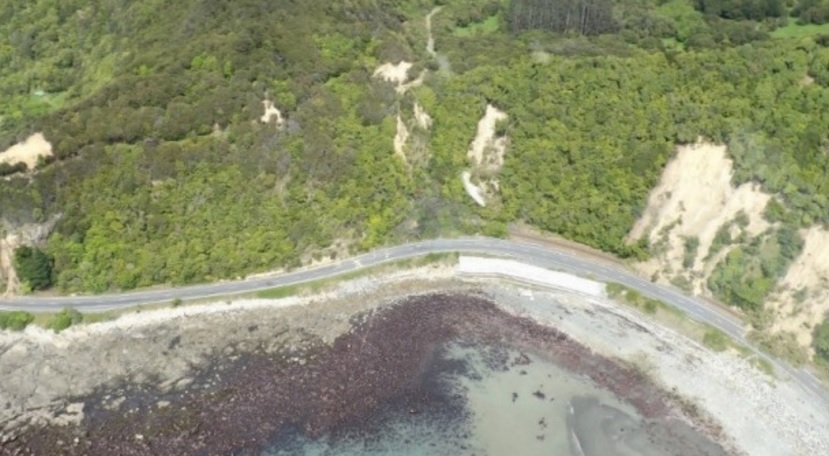Among the startling images of landslides, broken roads and railway tracks tossed aside by Monday morning’s Kaikoura earthquake, we’ve also seen pictures of coastal areas thrust upward and out of the water.
 We asked marine experts about what happened.
We asked marine experts about what happened.
Dr Joshu Mountjoy, marine geologist, National Institute of Water and Atmospheric Research (Niwa)
“Multiple tectonic fault lines have broken the earth surface onland during 2016 Kaikoura Earthquake and it is clear that several of these faults continue offshore.
“NIWA has mapped offshore faults in detail along the coastline from Kaikoura to Cook Strait. At the moment we cannot say for certain which faults this complex earthquake has occurred on. From the initial reports of fault rupture location it is clear that there are some gaps in our knowledge of the offshore distribution of faults.
“It is apparent from initial reports that the land has been uplifted as expressed on the coastline.
“In places like Wairarapa and Mahia Peninsula co-seismic coastal uplift (which happens during earthquakes) is widely recognised. At Turakirae Head on the south coast of the North Island multiple uplifted beach ridges reflect vertical uplift of the land of several metres in each earthquake.
“Much more information is needed before the connection can be made between specific offshore fault movement and coastal uplift.”
Dr Ashley Rowden, marine ecologist, Niwa
“Physical movement and deposition of sediment and rock as ‘landslides’ and also suspended sediment as ‘turbidity flows’ – caused by the earthquake – are disturbances that can impact seafloor animal communities in the deep sea (e.g. in Kaikoura Canyon). Animal communities on the seafloor can also be indirectly affected by the transport of suspended sediment beyond the areas of physical movement. Suspended sediments can be at a density that impacts the feeding ability of some seafloor animals as well as the functioning of plants and animals that live in the water (plankton).
“Impacts on deep seafloor animal communities can also occur because of changes caused by the earthquakes in shallow water. For example, uplift of the seafloor in the intertidal area and in shallow seas can cause the death of large macro algae (kelp) (they become stranded). Kelp supplies organic material that can be transported offshore and used by animals in the deep.
“Overall, one can expect the earthquake to have an influence on the structure and functioning of coastal and deep water communities. The extent of these effects is unknown, in terms of magnitude, spatial area and resilience, and requires research to understand it.”
Professor Jeff Shima, director, Coastal Ecology Lab, Victoria University of Wellington
“The images of uplifted rocky reefs covered with dying paua, crayfish, and seaweeds are striking. The extent of this uplift is not yet clear—but without question, the affected areas will experience significant changes in the quantity and composition of marine life. Recovery could take years. And the ‘recovered’ state could look quite different.
“The seaweeds and animals that inhabit these areas are remarkably resilient. They tolerate pounding by large waves and the rise and fall of the tides every day. They produce large numbers of offspring that can travel great distances to replenish distant sites. But they are also carefully tuned to their environment, and they are incredibly sensitive to water depth and tidal levels. Changes that take a long time to happen will have comparatively little effect, because organisms can respond with adjustments to their physiology and/or a shift in their distributions over many generations. Changes that happen quickly are a problem.
“We know that small changes in tidal fluctuations can have big effects on the marine life in these communities. Rapid coastal uplift (or subsidence) will have ecological consequences that are even more severe. The effects of a coastal uplift (of 40-60cm) following an earthquake that struck Chile in March of 1985 is particularly well documented: the affected sites experienced catastrophic mortality of many species (including important habitat-forming seaweeds). Recovery took years.
“Recovery will happen along the Kaikoura coastline. Remnant populations of affected species may be present beneath the new land-sea interface, and at nearby locations that did not experience uplift to the same extent. Offspring produced by these populations will replenish affected areas. Some species will take longer than others to recover. And much will depend upon what happens to important habitat-forming seaweeds.
“One silver lining—the Kaikoura system is among the best-studied coastlines in New Zealand. Researchers with long-term data on this system will be well-placed to make predictions. And continued monitoring of this system in the aftermath of the uplift event will strengthen our scientific understanding and enable us to make even stronger predictions in future.”